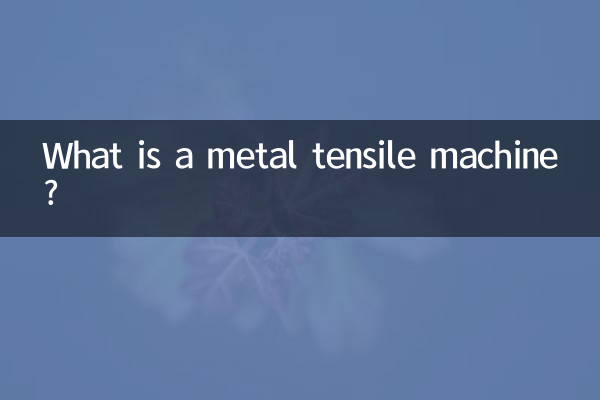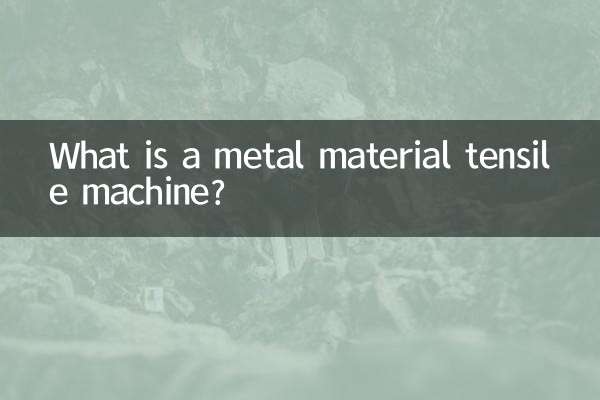What is a metal tensile machine?
The metal tensile machine is a professional equipment used to test the mechanical properties of metal materials. It is widely used in industrial manufacturing, materials research, quality inspection and other fields. It measures key parameters such as tensile strength, yield strength, and elongation of metal materials by applying tensile force, providing a scientific basis for material performance evaluation. The following is a detailed introduction to metal tensile machines.
1. Working principle of metal tensile machine

The metal tensile machine applies tensile force to the metal sample through a hydraulic or electric drive system, and records the force value and deformation through high-precision sensors. During the test process, the equipment generates a stress-strain curve to help users analyze the mechanical properties of the material.
| components | Function description |
|---|---|
| Load system | Provides stable tensile force, divided into two types: hydraulic type and electric type |
| Force measuring system | High-precision sensor to measure the tensile force endured by the specimen |
| Deformation measurement system | Record the elongation of the specimen and calculate the strain |
| control system | Control the test process, collect and process data |
| software system | Analyze data and generate test reports |
2. Application areas of metal tensile machines
Metal tensile machines play an important role in multiple industries. The following are its main application areas:
| Industry | Application scenarios |
|---|---|
| metal manufacturing | Test the mechanical properties of steel, aluminum alloy, copper and other metal materials |
| Automobile industry | Evaluate the strength and durability of automotive component materials |
| Aerospace | Testing the tensile strength and fatigue properties of aerospace materials |
| construction project | Test the load-bearing capacity of steel bars, steel structures and other building materials |
| Scientific research institutions | Study the mechanical behavior of new materials and optimize material formulas |
3. Technical parameters of metal tensile machine
The performance of the metal tensile machine depends on its technical parameters. The following are common technical indicators:
| parameters | Description |
|---|---|
| Maximum test force | The maximum pulling force that the equipment can exert, common range: 10kN-1000kN |
| Force accuracy | Accuracy of the force measuring system, usually ±0.5% or better |
| Stretch speed | Sample stretching rate, adjustable range: 1-500mm/min |
| Valid itinerary | The maximum length of the stretch space, usually 600-1000mm |
| Test standards | Comply with ISO, ASTM, GB and other international or national standards |
4. Selection guide for metal tensile machines
There are many factors to consider when choosing the right metal tensile machine, here are some key points:
| Considerations | Suggestions |
|---|---|
| Testing requirements | Determine maximum test force and accuracy requirements based on material type and testing standards |
| Device type | The hydraulic type is suitable for large-tonnage testing, and the electric type is suitable for high-precision and small-tonnage testing. |
| Brand reputation | Choose well-known brands to ensure equipment quality and after-sales service |
| budget | Balance performance and price according to your budget and avoid blindly pursuing high-end configurations |
| Extended functions | Consider whether you need testing capabilities in special environments such as high temperature and low temperature |
5. Maintenance and maintenance of metal tensile machines
In order to ensure the long-term stable operation of the metal tensile machine, regular maintenance and upkeep are essential:
| maintenance items | Operating Instructions |
|---|---|
| cleaning equipment | Regularly clean dust and oil on the surface and inside of the equipment |
| Check sensor | Ensure the accuracy of force and deformation sensors and calibrate them regularly |
| Lubricated parts | Lubricate moving parts to reduce wear |
| Check electrical system | Make sure wiring connections are secure to avoid electrical faults |
| Software updates | Update test software in a timely manner to fix bugs and improve functionality |
6. Future development trends of metal tensile machines
With the advancement of science and technology, metal tensile machines are developing in the direction of intelligence and automation:
| Trend | Description |
|---|---|
| Intelligent | Integrate AI algorithms to automatically analyze data and provide optimization suggestions |
| Automation | Realize full automation of specimen clamping, testing, and data analysis |
| High precision | Use more advanced sensors to improve force and deformation measurement accuracy |
| Multifunctional | One device integrates multiple test modes such as tension, compression, and bending |
| remote monitoring | Remote operation and fault diagnosis through IoT technology |
Conclusion
As an important tool for material testing, the performance and application range of metal tensile machines are constantly expanding. Whether in the field of industrial manufacturing or scientific research, metal tensile machines play an indispensable role. By understanding its working principles, application areas and maintenance methods, users can better select and use equipment and improve testing efficiency and accuracy. In the future, with the advancement of technology, metal tensile machines will become more intelligent and multifunctional, providing stronger support for the development of materials science.

check the details

check the details